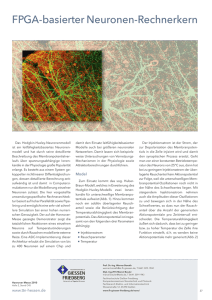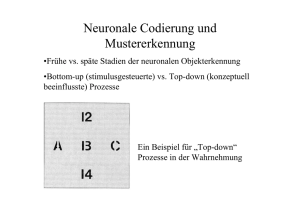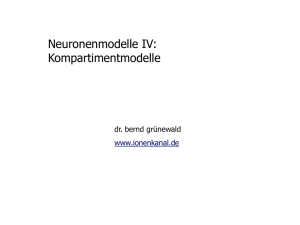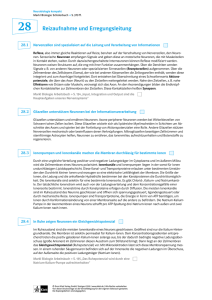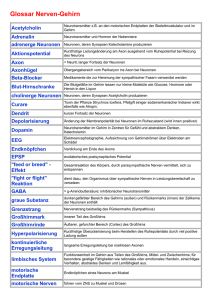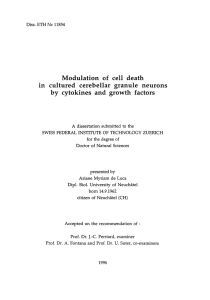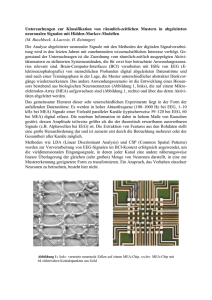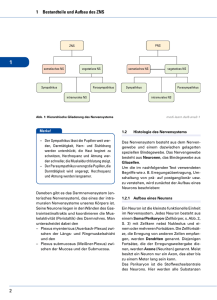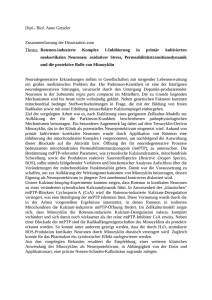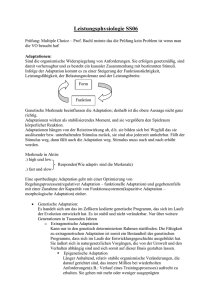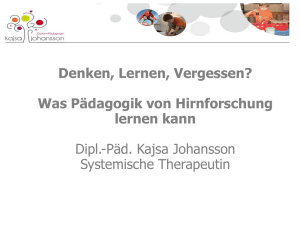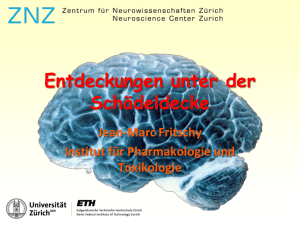on contrast adaptation and normalization in the - ETH E
Werbung
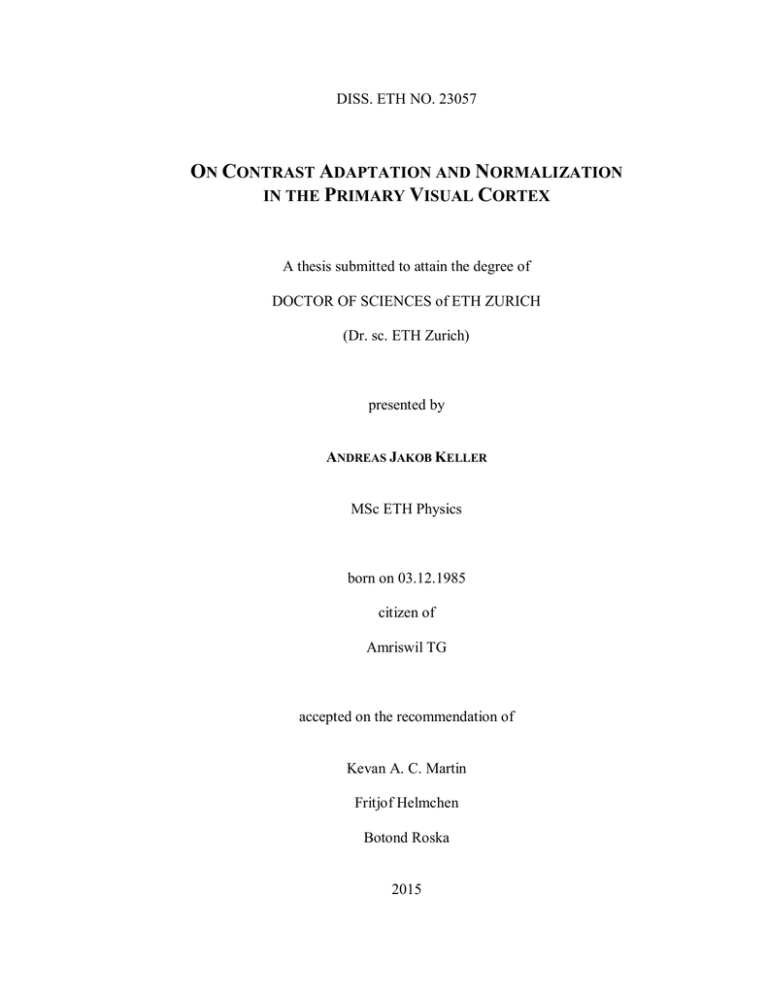
DISS. ETH NO. 23057 ON CONTRAST ADAPTATION AND NORMALIZATION IN THE PRIMARY VISUAL CORTEX A thesis submitted to attain the degree of DOCTOR OF SCIENCES of ETH ZURICH (Dr. sc. ETH Zurich) presented by ANDREAS JAKOB KELLER MSc ETH Physics born on 03.12.1985 citizen of Amriswil TG accepted on the recommendation of Kevan A. C. Martin Fritjof Helmchen Botond Roska 2015 10 ZUSAMMENFASSUNG Sensorische Neuronen signalisieren die Zunahme der Intensität eines Stimulus (Licht, Schall, Berührungen, etc.) mit der Erhöhung der Rate mit der sie Aktionspotentiale produzieren. Die Spannweite der Intensitäten, die in der Natur vorkommen, ist normalerweise gross und Neuronen können nicht mehr als einige hundert Aktionspotentiale pro Sekunde abfeuern, deshalb kann ein ‘Raten-Code’ nur eine limitierte Spannweite der Intensitäten des Stimulus abdecken. Im visuellen Kortex wird diese Limitation durch einen Mechanismus überwunden, der die abgedeckte Spannweite der Neuronen langsam verschiebt und dem durchschnittlichen Kontrast der visuellen Umgebung anpasst. Erhöht sich der Kontrast in der Umgebung, antworten die Neuronen mit einer schnellen Erhöhung der Feuerrate, die dann langsam wieder abnimmt während der Kontrast stark bleibt. Wie dieser letztere Prozess, den man ‘Kontrastadaptation’ nennt, funktioniert, ist unbekannt. Indem wir die Aktivität vieler Neuronen mit optischen Methoden aufgezeichnet haben, haben wir entdeckt, dass lokale Netzwerke von Neuronen gemeinsam eine viel grössere Spannweite von Kontrasten abdecken als individuelle Neuronen. Während die meisten Neuronen im visuellen Kortex der Katze als Antwort auf eine aufrechterhaltene Erhöhung des Kontrasts adaptieren, zeigen zwei GABA-Zelltypen (i.e. vermeintlich inhibitorisch) keine Adaptation, jedoch paradoxerweise eine Erhöhung ihrer Feuerrate. Diese GABA-Neuronen könnten folglich die inhibitorischen Elemente im Netzwerk sein, die die Reduktion der Feuerrate anderer Neuronen verursachen. Wir haben dann den primären visuellen Kortex der Maus als Modellsystem für Kontrastadaptation etabliert und haben gezeigt, dass Adaptation ein kortikaler Prozess ist. Wir haben gezeigt, dass Neuronen, die im anästesierten Tier adaptieren im wachen unbeschäftigten Tier ihre Aktiviät beibehalten. Zudem werden wesentliche Bruchteile der Neuronen von dem Stimulus underdrückt und verringern ihre Aktiviät gegenüber der spontanen Feuerrate. Schluessendlich haben wir gezeigt, dass Kontrastadaptation wiederauftritt, wenn die Mäuse sich einer Aufgabe widmen und dabei lernen die visuelle Information ausserhalb des Teststimulus zu verwenden. Wir haben konnten nachweisen, dass die Kontrastadaptation im wachen Tier moduliert wird, und spekulieren, dass dies durch höhere Hirnfunktionen, wie die Relevanz des Stimulus oder Aufmerksamkeit des Tiers, auftritt. 11 SUMMARY Sensory neurons signal increases in the intensity of a stimulus (light, sound, touch etc.) by increasing the rate at which they produce action potentials (spikes). Since the range of intensities encountered in nature is typically wide and neurons cannot fire at rates higher than a few hundred spikes per second, ‘rate coding’ alone can only represent a limited range of stimulus intensities. In the visual cortex, this limitation is overcome by a mechanism that slowly shifts the operating range of neurons to match the mean contrast of the visual scene. If the contrast of the scene increases, the neurons respond by rapidly increasing their rate of spiking, but then slowly decrease their rate if the contrast stays high. How this latter phenomenon, called ‘contrast adaptation’, works is unknown. By optically recording many neurons simultaneously, we discovered that networks of neurons collectively code for a much wider range of contrasts than individual neurons. While most neurons in the cat’s visual cortex adapt their firing rate in response to increases in contrast, two types of GABAergic (i.e. putative inhibitory) neurons show no adaptation, but paradoxically increase their firing rate. These GABAergic neurons could thus be the inhibitory elements in the circuit that cause other neurons to reduce their firing. We then established mouse primary visual cortex as a model system to study contrast adaptation, and showed that adaptation is a cortical phenomenon. We showed that neurons that adapt under anesthesia maintain their activity in the non-engaged mouse. Moreover, substantial fractions of neurons are suppressed by the stimulus and decrease their activity from baseline. Finally, we showed that adaptation reappears if the mice are engaged in a task and learn to use visual information away from the probe stimulus. We have demonstrated that cortical contrast adaptation is modulated in the awake animal, and we speculate that this might occur via a top-down mechanism such as the relevance of a stimulus or attention.
